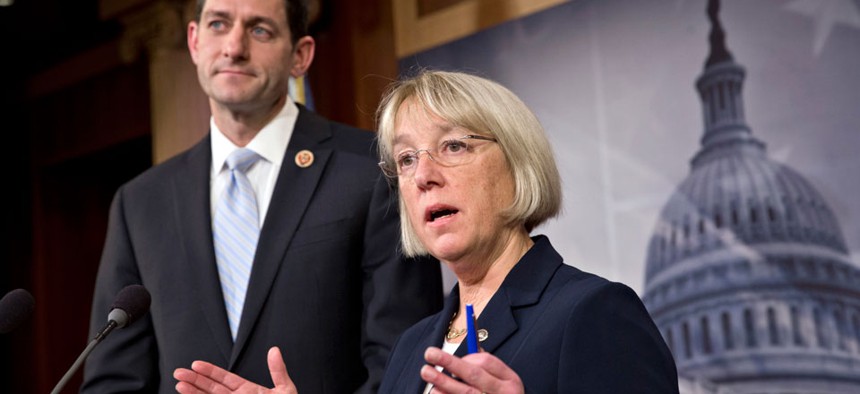
House Budget Committee Chairman Paul Ryan, R-Wis., left, and Senate Budget Committee Chairwoman Patty Murray, D-Wash. J. Scott Applewhite/AP
Where the Savings in the Budget Deal Will Come From
Federal employee pension reforms aren't the only source of savings in the plan.
Requiring newly employed federal employees to pay more into their pension funds and charging airline travelers a higher security fee are the two most talked-about moves to offset spending in the budget deal pending before Congress.
But a crazy quilt of other ideas, from the quirky to the speculative, also are part of the plan—such as cracking down on prisoners who somehow receive unemployment checks and making dead-certain that dead people don't get tax refunds.
Unimpressed, some conservative and taxpayer groups on Wednesday likened these proposals to smoke and mirrors, labeling them weak promises of future savings made in return for more spending today.
The crafters of the budget deal, Republican Rep. Paul Ryan and Democratic Sen. Patty Murray, insist the projected savings are real. "All in all, we provide $63 billion over two fiscal years in sequester relief, which is replaced with $85 billion in mandatory savings, for a net deficit reduction of $23 billion," Ryan said during a House Rules Committee hearing Wednesday.
"We stop paying Medicaid bills that deadbeat dads should be covering, we stop sending unemployment checks to criminals," Ryan said, ticking off some of the proposals to realize savings by lowering spending, curbing fraud and waste, or increasing fees.
But closer scrutiny shows that a good chunk of the savings is to be spread out over 10 years. And some critics also say they have little faith lawmakers are capable of staying true to such commitments to spending caps a decade from now.
"It's laughable," says Tad DeHaven, an expert on federal and state budget issues for the Cato Institute. "It's only been two years and they are going back on the sequester. It goes to show you how worthless long-term commitments are.… Congress could change this deal by the time we're off the phone," he told a reporter Wednesday.
According to figures put out by Murray and Ryan's offices, some of provisions pitched as bringing in savings to offset the added spending include:
- About $786 million over 10 years—including $517 million in increased revenues or penalties through a crackdown on fraudulently claimed tax refunds—by blocking misuse of the ominously named "Dead Master File." The Commerce Department would impose greater restrictions on access to the list of dead people and their Social Security numbers;
- An estimated $242 million over 10 years by going after prisoners who illegally claim federal benefits, including $162 million tied to preventing improper tax refunds;
- About $1.4 billion over 10 years by reinforcing Medicaid's standing as the payer of last resort, including allowing states to collect medical child support in cases where health insurance is available from a non-custodial parent;
- An estimated $7.9 billion over 10 years by raising the premiums companies pay the federal government to guarantee their pension benefits;
- An estimated $3.1 billion savings over 10 years by eliminating special carve-outs for nonprofit student-loan servicers;
- More than $1.5 billion over 10 years by permanently canceling the unobligated balances of the Justice Department's Asset Forfeiture Fund and the Treasury Forfeiture Fund.
In addition, raising the Transportation Security Administration's security fees on airline tickets is estimated to bring in another $12.6 billion in savings over 10 years.
Another $25 billion in savings is projected as a result of approving an agreement with Mexico to jointly explore and develop offshore hydrocarbon resources; nearly $6 billion would be saved over 10 years by increasing federal employee pension contributions by 1.3 percentage points; and another $6 billion would be generated over 10 years by changing the annual cost-of-living adjustment for working-age military retirees.
But are all of these projected savings real?
"Efforts to curb waste, fraud, and abuse in entitlement programs are worth a lot of praise, but they've served as pay-fors in a number of [previous] budget plans," said Pete Sepp, vice president of the National Taxpayers Union. "How will these be different, in that they'll actually deliver on the promised savings?"
Sepp and others also say many of these proposals are actions Congress and federal agencies should have taken already.
"We've known about unobligated balances in various federal accounts for several years now.... Why wait until yesterday to announce that something was being done about it, at least for a few agencies?" Sepp asked on Wednesday.
Cato's DeHaven added: "One of the things is to crack down on fraud—people getting unemployment benefits while in prison. Well, why aren't you doing that already?"
Ryan Alexander, president of Taxpayers for Common Sense, complained: "The deal's authors are using a patchwork of questionable offsets and budgetary optical illusions instead of responsibly replacing possible across-the-board sequestration cuts with real deficit reduction. This is just a thinly veiled attempt to hide real spending increases that bust the budgetary caps both chambers and the president agreed to only two years ago."
NEXT STORY: Republican Senators Say Budget Will Pass







